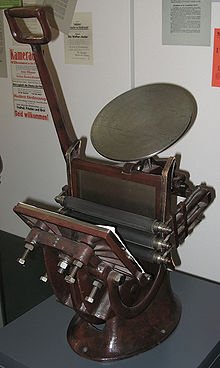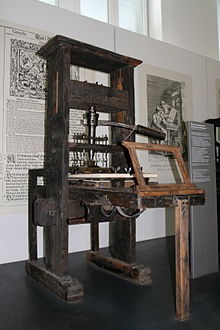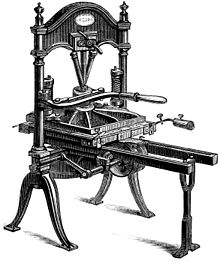Platen printing press
In printing technology, a printing press is referred to as a platen printing press , in which both the pressing body and the counter-pressure body each form a flat surface. The flat counter-pressure body is called a crucible. Often the entire platen press is shortened pot called.
Printing principle
Platen printing presses are hand presses or printing machines that are designed for high pressure and work according to the pressure principle surface against surface. The substrate is fed through the platen parallel to the printing forme and printed with very high contact pressure in the order of several tens of tons .
In a platen printing press, the printing form is often vertical and is colored by a rotating ink roller. The printing material is brought into the printing form with great force via a printing platen equipped with a lift. The pressure level is set using a rotatable lever system or a wedge system. This has the advantage that the pressure strength of the respective printing form can be adapted, since each printing form requires a different pressure strength.
The crucible is the movable counter plate that carries the elevator and usually also serves as a paper system.
application
With a platen printing press, due to the high demands on the evenness of the platen (plate), only formats up to about DIN A3 can be neatly printed. For this reason, platen presses are mainly used for printing small-format products, for example for printing cards, letterheads, labels and brochures. However, platen printing presses can also be used for embossing, creasing and punching, even in a joint operation with printing.
Construction types
A distinction is made depending on the arrangement of the printing form, the structure of the foundation and the movement of the pan.
- Screw press ( screw press )
- Stanhope press ( toggle press )
- Boston system : It was built by Isaac Adams and is mainly used in small commercial printing companies. The foundation is vertical and firm. The crucible moves around a wave below the foundation towards the printing form. The movement can be done by tie rods or toggle levers.
- Liberty system : The foundation is movable and on a shaft together with the crucible on which the paper is placed. The Liberty crucible has two identical sides for the crucible and the pressure base , which fold together around a common pivot point when pressure is applied, hence the name hinge press. The pan opens very wide, so the print sheet can be laid out well.
- Gally system : The set foundation is vertical and is firmly connected to the base frame of the press, while the crucible (paper system) is guided on a slide. The Gally crucible press has a freely mounted crucible that is brought parallel to the foundation via a system of slide rails, lugs and push / pull rods. Shortly before printing, the crucible assumes a parallel position to the foundation and is pressed against the printing form by means of tie rods.
- Gordon system : The set foundation moves around a horizontal shaft, while the crucible (paper plant) is movable on a separate horizontal axis. The crucible and the foundation move towards each other around two separate axes.
Automatic crucible
The term machine distinguishes the hand crucible from the fully automatic system, the crucible machine . With the machine, both the paper system and the inking and the delivery are independent of the operator. Platen printing machines are still used today for punching and embossing work in modern printing. For example, it is possible to apply holograms to materials that have already been printed. Since two flat surfaces press against each other on the crucible, the substrate is not exposed to any mechanical stress that could lead to tearing or breaking. This means that even plastic cards (such as EC cards) can be provided with holograms and marking strips in this way.
A distinction is made between automatic crucible machines with a propeller gripper system (original Heidelberg crucible machine (windmill), GrafoPress crucible printing press) and automatic crucible machines with a separate feed system (such as Kobold machine, PhönixA crucible or Victoria crucible printing press).
Each type of crucible has specific advantages and disadvantages in printing. In Germany only the Gally presses (example Victoria presses ) and the Boston presses (example Heidelberger OHT ) prevailed.
The hourly output of the automatic platen is around 5500 prints (Heidelberger Tiegel). This speed can only be used for work that does not have to be in register . In practice in the 2010s, you will rarely see an automatic crucible being operated at top speed. In addition to the register problem, it also plays a role that wear is negligibly small at low speeds . The multi-color printing , which simulates the color tones by means of fine grids and overprinting (4-C), should not be done using small hand-applied jars. Spot colors, on the other hand, are mixed before printing and then printed one after the other. One printing block (cliché / set) and one printing pass are required for each color. Printing with real colors / spot colors also simplifies the use of special colors, especially silver or gold. The Heidelberg crucible machine is also suitable for printing small color images. However, the four (one each for yellow, cyan, magenta and black) printing blocks (clichés) must be screened accordingly for 4-color printing (4C) .
Printing inks for platen printing machines must have a low speed so that the printed sheet can be easily removed from the press after printing.
Hand pot
A hand crucible is the name given to small printing presses that work according to the crucible pressure principle and that are mostly driven by muscle power. These presses were primarily used for commercial jobs, i.e. for business cards, stationery, memorial cards, etc., as they were much cheaper to buy than the automatic crucibles. They are therefore also operated by small print shops.
Hand crucibles have been built since 1800 and still represent the majority of all printing presses ever built. They are built in the format range from postage stamp size to A3 +. In addition, the necessary pressure force is too great and the crucible with power drive is preferred. For punching and embossing work there are crucibles with a printing area of 70 × 100 cm. Flywheel-driven hand crucibles (generated by manual drive and transmission ) are also known, such as the Hogenforst EXPRESS.
The inking rollers (up to DIN A4 there are usually two pieces, with DIN A3 usually three) are partially supported by the plate inking unit or one or more distribution rollers in the hand pot. In Germany, hand -held crucibles are primarily of the Boston design, but also as Gally , Liberty or Gordon crucibles . One type of Boston crucible are toggle presses (e.g. Heidelberg, Hohner, Heidsieck); however, the Degener and Weiler machines use tie rods. Small hand presses (for business cards and slightly larger) use a simple Boston design that does not require a “ knee joint ”.
The crucible opens by moving the handle upwards. The paper is then inserted into the press by hand. The dyeing is carried out using two application rollers. The printing form is closed in the frame with at least two closing tools . It is then placed in the crucible's mold bed and fastened there. The pressure platen is operated with the hand lever, e.g. B. via the toggle system, pressed against the printing form. After pressing the handle is pushed up and the pan opens. The printed sheet can be removed.
History and Development
Around 1450 Johannes Gutenberg adapted an already existing screw press (wine press / wine press ) to his purposes and provided it with a mechanism that allowed the form and paper to be easily brought under the printing part of the press and just as easily out of it.
The first illustration of a press for printing are 1507 printer character of the Paris book printer Iodocus Badius : it shows the press of wood, as it has been used four and a half centuries after the invention in its characteristic, very crude forms. The main parts of such are the frame and the cart. The former consists of two vertical side walls (cheeks) connected by an upper transverse beam (crown); a lower connecting beam carries the rails on which the cart, ie the part of the press that carries the printing form, with the foundation (a polished iron plate), cover and frame is rotated in and out of the press by means of a crank and drive belt. The pressure is exerted by the crucible, but this, a plate made of metal (on the oldest presses made of wood), hangs horizontally on hook bars at the lower end of a powerful screw, the press spindle, which runs in two inner connecting beams located between the press walls. Of these, the upper one rests in mortises with elastic bearings, while the lower one (the bridge) is fixed; it is surrounded at the top by a sturdy screw nut, and at the bottom it exerts its pressure on the center of the crucible in a pan with a hardened steel tip. From the center of the spindle a strong iron lever with a wooden handle (scabbard) and a swing ball protrudes horizontally, the press kid; its pulling causes the downfall of the crucible, resp. the exercise of pressure.
The lid sits in threads on the cart, as does the frame on the former. In the lid, however, the punctures, on fork-like, adjustable iron, are held in place by screw heads, into which the sheets are pierced before printing, in order to be able to keep the register when printing the second form (the reverse printing ), i.e. the pressure must be done in such a way that the sides of the front and the back cover each other.
The frame has to hold the sheet in place in the lid and protect it from soiling in the areas that remain white; it is therefore completely covered with paper before the start of printing, and only those areas are cut out which are actually to be printed on from the sheet.
The press includes the paint table , on which the paint is spread thinly and rubbed with the roller, but then "applied" to the mold by repeatedly rolling over it with the roller.
The first improver of the press is said to have been the printer Danner in Nuremberg about a hundred years after Gutenberg, when he replaced the spindle, which had been made of wood or iron, with one made of brass. He was followed around 1620 by the Dutchman Willem Janszoon Blaeu , who attached a downwardly curved, strongly resilient plate above the crucible (under the so-called bridge), which, by straightening it, reduced its suddenness during pressure and reinforced it, but at the same time also added to it the slacking of which snapped the squeeze back.
A press constructed almost entirely of iron was first created in 1772 by the type founder Wilhelm Haas, and his son and successor of the same name improved it.
The Haassche press was modeled on an embossing mechanism, and like this, the movement mechanism, the villain , was located above the cast-iron press frame. The spread of the Haasschen press was hampered by narrow-minded guilds.
In April 1789, the court printer Philippe-Denis Pierres presented the first design of a folding platen press in Paris. The foundation with the printing form rested in a box-shaped wooden stand. An eccentric system was attached underneath. This generated the contact pressure instead of the spindle. The crucible was attached to the frame by iron hinges. The printing process was the same as with previous presses, but stronger pressure was applied. This enabled the printing form to be printed out in full. In addition, this press made it easier to swivel back into the starting position.
Around 1800 Charles Stanhope built a press made entirely of iron, the powerful mechanism of which allowed a mold to be pressed with a single pull, carried out with one hand, while the wooden press required two and pulling with both hands. With the help of the technician Walker, the Stanhope press was manufactured, which was first installed in the Bulmers print shop, a well-known printer in London at the time.
Independently of Stanhope, Friedrich Koenig had also strived to improve the press. On March 29, 1810, Friedrich Koenig received a patent for his platen printing machine. In April 1811 the "Annual Register" was first printed for 1810 with a print run of 3,000 copies. The printing performance of this machine was 400 sheets per hour. Compared to previous platen printing machines, this one had some innovations.
In addition, a mill was used to provide the drive. There were two applicator rollers, one of which inks the printing forme on its way there and the other on its return. This was achieved by alternating raising and lowering. The coloring was improved by using a paint can with a triple guide.
The cart was moved forwards and backwards by drive belts or a chain over a cord wheel and end pulleys. The mechanical system was modified in such a way that a movement of the crucible and the cart was achieved which allowed the cart to stand still twice during the up and down movement of the crucible.
This first platen printing machine from Friedrich Koenig could not establish itself and a year later it was redeveloped. After years of effort he came up with the invention of the high-speed press , in which the principle of the crucible press "flat against flat" was replaced by the new principle "flat against round". But at first it was just a hand press with mechanical coloring and operation.
The American George Clymer created a very powerful press in the Columbiapresse in 1817 , in which the screw spindle was replaced by a combined lever mechanism and the press was made suitable for printing even the heaviest forms, but the work was made much easier for the printer by the excellently constructed mechanism.
"Improved constructions" followed quickly from now on, according to the "Scottish press" by John Ruthven , in which not the crucible but the foundation was fixed, as was the case with all previous designs, while the former was moved back and forth on rollers. The presses of the Americans W. Hagar and S. Rust, the Hagarpresse and the Washingtonpresse , first built in Germany by Christian Dingler in Zweibrücken and named after him, the Dinglerpresse , achieved general acceptance .
It exerts the pressure by straightening one or more knees when pulling the urchin and is very powerful with the simplest construction. The same principles form the basis of the presses built by numerous other manufacturers since Dingler in Germany, and the Albion press , now widely used in England and first built by RC Cope, is just a simplified and improved Hagar press, the basic principles of which were developed by the press builders in Belgium and France have also been adopted and used according to needs.
The high-speed presses and accident machines had left the hand presses only a very limited area of work.
literature
- Fritz Funke: Book customer . 6th edition. KG Saur Verlag, Munich 1999, ISBN 3-598-11390-0 .
- Claus W. Gerhardt : History of the printing process . Part II. The printing. Anton Hiersemann Verlag, Stuttgart 1975, ISBN 3-7772-7521-2 .
- Gutenberg Museum Mainz (Ed.): From Gutenberg to WorldWideWeb . Dachs, Vienna 2002.
- Helmu Hiller, Stephan Füssel: Dictionary of the book . 6th edition. Vittorio Klostermann, Frankfurt am Main 2002. ISBN 3-465-03220-9
- Dieter Liebau, Hugo Weschke: Polygraph specialist lexicon of the printing industry and communication technology . Polygraph, Frankfurt am Main 1997.
- Walter Wilkes: high-speed letterpress presses and endless rotary presses of the 19th century . Volume 1. Technische Universität Darmstadt, Darmstadt 2004, ISBN 3-88607-152-9 .
- Hans-Jürgen Wolf Striker, Hermann Burkhardt: High pressure .Ravensburger book publishing, Ravensburg, 1994. ISBN 3-473-48382-6
- Hans-Jürgen Wolf: History of the printing press . INTERPRINT Druck & Verlag GmbH, Frankfurt / Main 1974.





